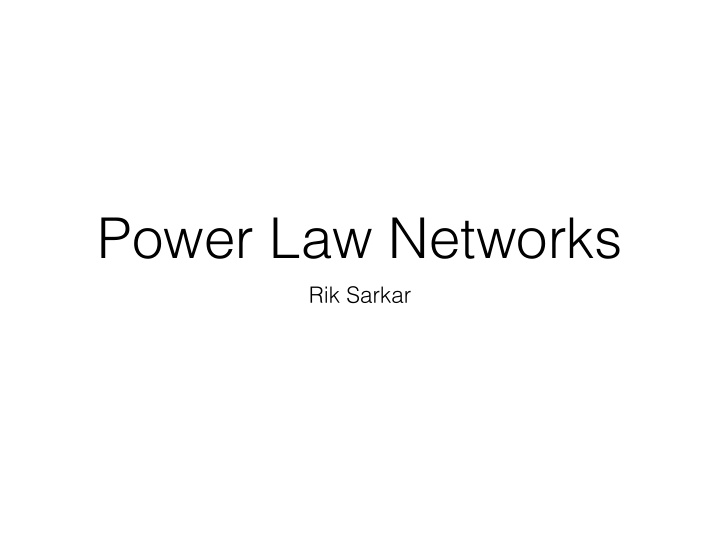



Power Law Networks Rik Sarkar
Degree Distribution • A more sophisticated way of characterizing networks • More complex than single numbers • Many standard networks are known to have “standard” degree distributions • Gives ways to incorporate notions of “popularity” and understand them
Degree distributions in networks • As a function of k, what fraction of pages in the network have k links? • A histogram
Degree Distribution in Random networks • Suppose we take a random network • What does the degree distribution look like?
Normal distribution and central limit theorem • Central limit theorem: The distribution of sum (or average) of n independent random quantities approaches a normal distribution with increasing n. • Applies to edges on a particular vertex • Normal distribution: 2 π e − ( x − µ ) 2 / (2 σ ) 1 P ( x ) = √ σ
Normal distribution • The probability density drops exponentially with distance from the mean. 2 π e − ( x − µ ) 2 / (2 σ ) 1 P ( x ) = √ σ
Degree distribution in www • Suppose we take a real network like the world wide web, and compute degree distribution. What does that look like? • Let’s try.
Degree distribution in www • Usually for www snapshots, number of nodes with in-degree k is approximately proportional to: 1 � k 2 • Usually, for www the exponent is slightly larger than 2
Power law • The variable concerned — degree or popularity etc changes as (for some constant ): α 1 � k α � �
Normal distribution vs power law in networks: • Normal distribution drops exponentially. That is very fast. P ( k ) ∝ e − ( k ) • Ignoring constants: • The probability of a node having a high degree (like 100) is small • Power law drops slower • Ignoring constants: P ( k ) ∝ k − α • Therefore probability of a node having high degree (like 100) is not so small
Power law networks • There are a fair number of “hubs” : heavy tailed distribution • Nodes that are very well connected • Important in Social networks: there are many popular people • Influence spread of epidemics • Influences strategies for product placement/advertising…
log-log plots
log-log plots are nice & straight
log log plots are not so nice! • The “straight” part needs to extend quite a few orders of magnitude • Fitting the straight line to determine the right coefficient alpha is not trivial due to non-linear nature of data • Beware: log-normal distributions can look similar to power law.
Mean of a power law distribution • The mean is finite iff α > 2 • Thus, average degrees on www should remain finite as www grows • May not be the case in other types of networks
Preferential attachment mechanism • We need a “model” i.e. a way to think about the creation of www that fits with the power law distribution • Idea: older and established (popular) sites are likely to have more links to them (yahoo, google…) • So how about: When a new page arrives, it links to older pages in proportion to their popularity • When a new link is created on a new page, randomly to older pages with probability of hitting a page x proportional to current popularity of x (number of links to x)
Preferential attachment model • Takes a parameter p: 0 ≤ p ≤ 1 • On a new page, create k links as follows: • When creating a new link: • With probability p • Assign it with preferential attachment mechanism • With probability 1-p • Assign it with uniform random probability
Preferential attachment model • Takes into consideration that popularity is not the only force behind link creation. • The randomly assigned links model other reasons for link creation. • Can be proven to produce power law. see [Kempe lecture notes, 2011] • Produces same exponent as www for p~0.9
Other reasons for power law • Optimization: • Power law found in linguistics (word lengths): most frequent words are short • Mandelbrot, Zipf : emerges from need for efficient communication • Random processes: • Press space with probability p, else press a random letter key • This will produce a power law distribution of word lengths
How realistic are preferential attachment graphs?
Diameter • Preferential attachment networks have small diameter
Expander properties • What do you think happens for real power law networks? • What about preferential attachment networks?
Recommend
More recommend